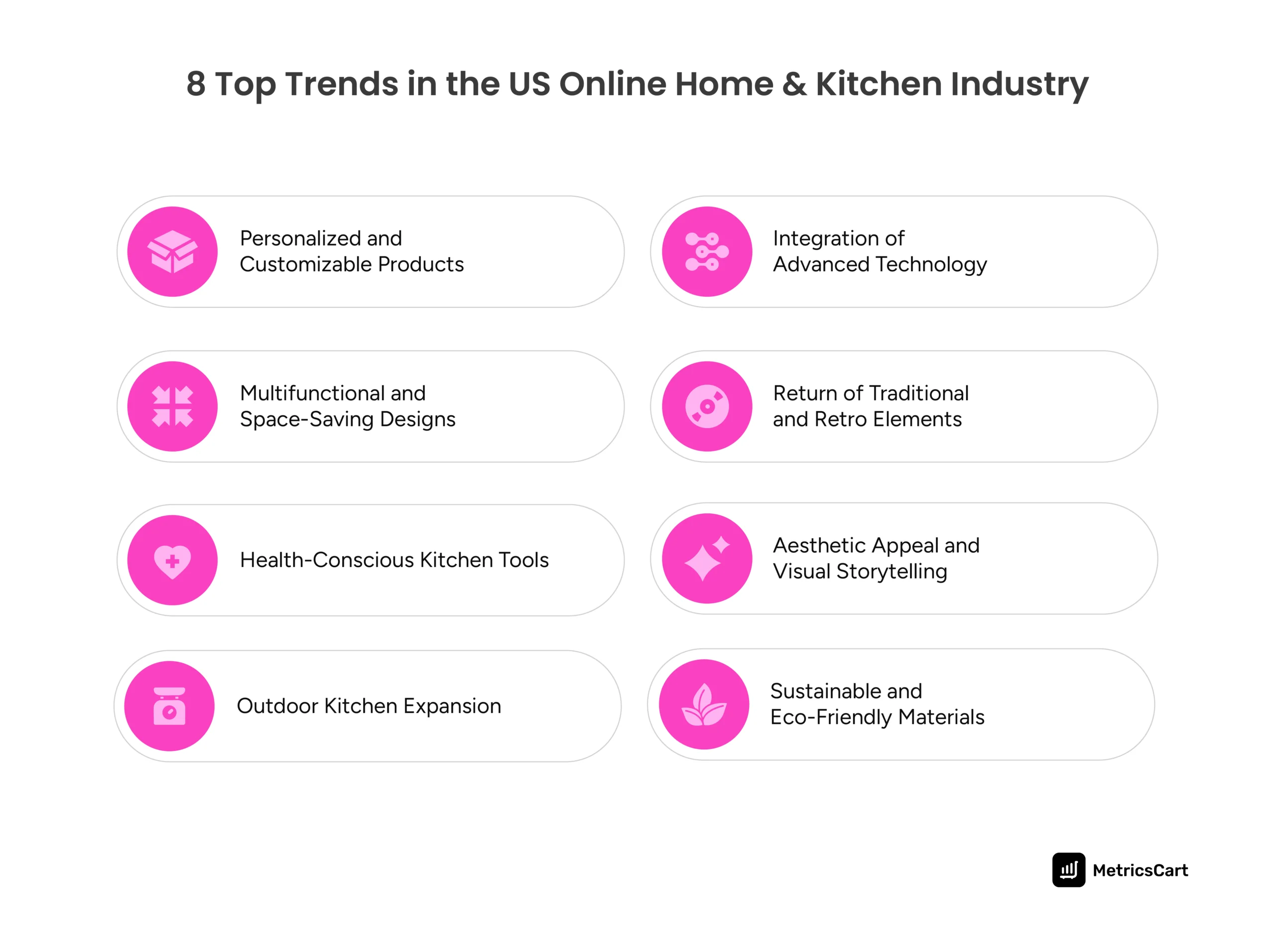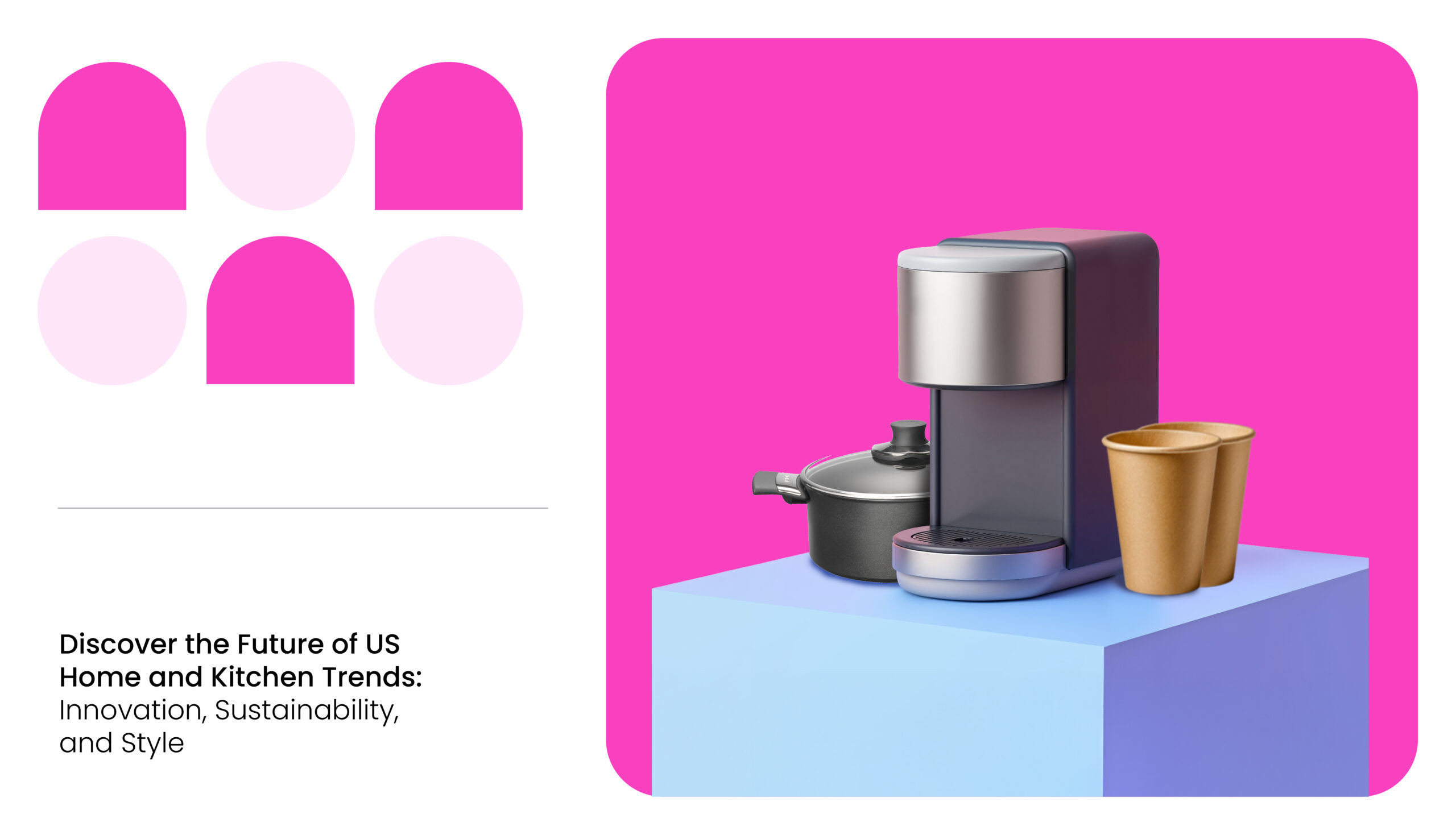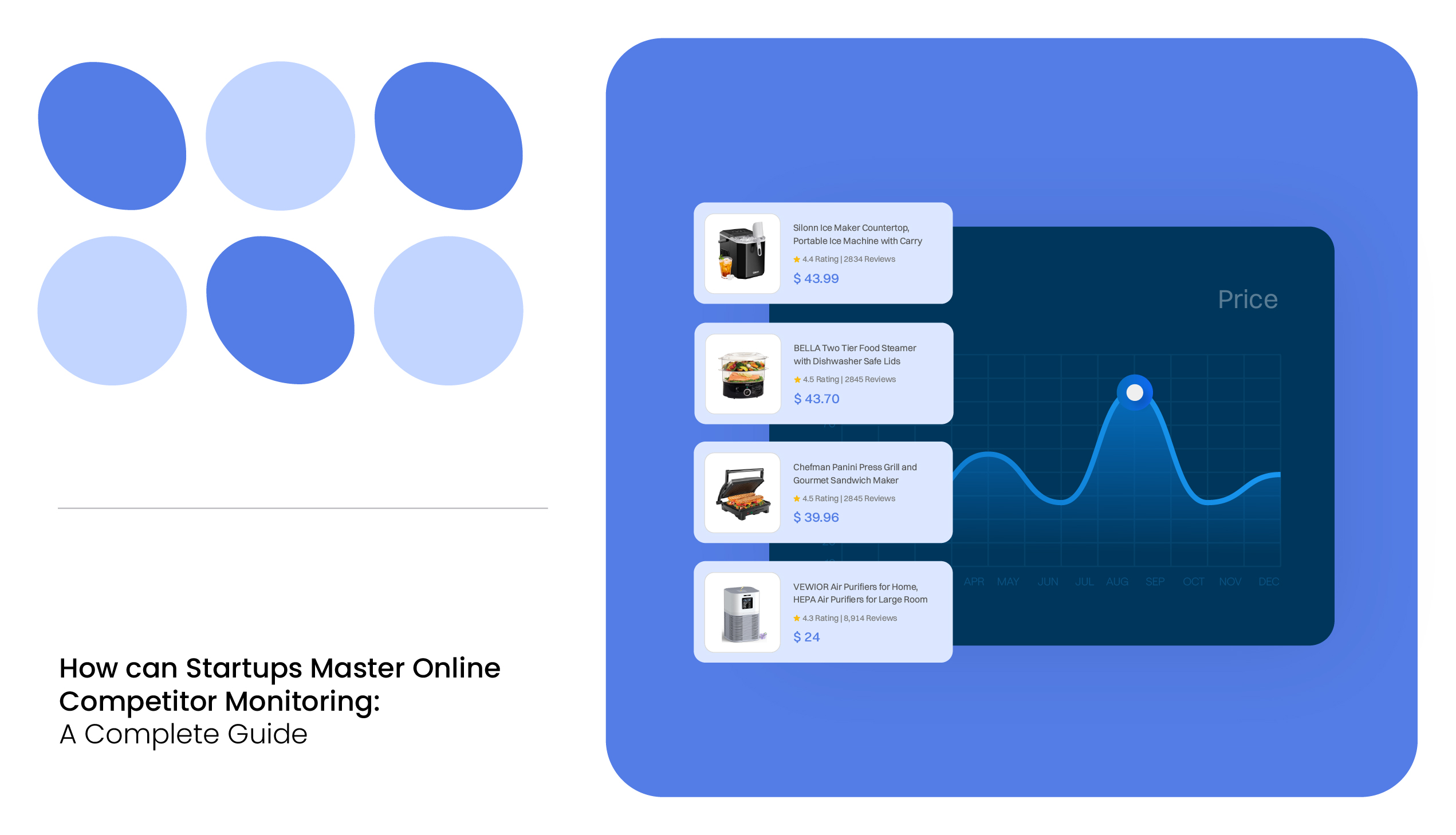The online home and kitchen industry in the US has seen tremendous growth in recent years, driven by technological advancements, changing consumer preferences, and a growing emphasis on convenience.
In 2024, the United States contributed 24.8% of the total global revenue in the home decor market. This reflects a robust demand for home products and kitchen essentials in general in the US online shopping market for the coming years.
As e-commerce becomes a dominant channel for home and kitchen purchases, understanding the home and kitchen trends in the US can help businesses and consumers navigate this dynamic market.
At MetricsCart, we provide data-driven insights that can help you better understand shifting consumer behaviors, optimize your product listings, and drive engagement.
By using our platform, home and kitchen brands can align with evolving trends and capitalize on the growing demand for eco-friendly, innovative products.
READ MORE | Looking to create the perfect online business strategy? Check out our blog on 10 E-Commerce Mistakes to Avoid For Successful Online Business.
8 Latest Trends in the Online Home & Kitchen Industry
As we move into the future of digital commerce, several emerging trends are reshaping the US home trends. These trends focus on innovation, sustainability, and personalization.
Here’s a closer look at some of the most significant developments:

Personalized and Customizable Products
Consumers are increasingly seeking personalized home and kitchen products that suit their unique needs and preferences. From customizable cabinetry and modular kitchen systems to personalized home decor items, the ability to create a space that feels truly unique is in high demand.
Brands like Cabinets To Go and IKEA have cashed in on this trend, offering customizable kitchen solutions and modular units that allow customers to design their layouts online, ensuring a perfect fit for their space and style. Similarly, Pottery Barn offers personalized kitchenware and decor that caters to individual tastes.
Integration of Advanced Technology
The integration of smart home technology is revolutionizing the kitchen space. Samsung and LG have led the way by offering connected appliances like smart refrigerators, ovens, and dishwashers, all controlled via smartphone apps.
GE Appliances’ SmartHQ platform allows consumers to control multiple kitchen appliances remotely, from adjusting refrigerator temperatures to setting cooking timers.
As smart home technology continues to develop, more brands are expected to incorporate innovative features into their kitchen products, making it easier for consumers to streamline their daily routines.
Multifunctional and Space-Saving Designs
With more people living in urban environments where space is limited, multifunctional and space-saving designs are gaining traction. Companies offer innovative storage solutions like pull-out pantry units and corner cabinets that optimize space and increase functionality.
Cuisinart has also introduced compact, all-in-one kitchen appliances that save valuable countertop space while still delivering excellent performance.
Additionally, IKEA continues to be a leader in space-efficient designs, with items like collapsible kitchenware and multi-purpose furniture that cater to small apartment dwellers or people seeking to maximize their kitchen storage.

Return of Traditional and Retro Elements
Nostalgia is making a comeback in the US home trends. KitchenAid, known for its iconic stand mixers, has embraced the retro trend by releasing a range of appliances in bold, vintage-inspired colors.
Similarly, Smeg offers a line of retro-styled refrigerators, blenders, and toasters that evoke a mid-century aesthetic. These products blend traditional design elements with modern functionality, appealing to consumers who appreciate both style and performance.
Health-Conscious Kitchen Tools
The growing interest in health and wellness is driving consumers to invest in kitchen tools that support healthier cooking practices.
Ninja, for example, has seen significant success with their air fryer and food processor combos, which allow consumers to prepare low-fat, nutrient-rich meals at home.
Another prominent example is Vitamix, known for its high-performance blenders. These products enable users to create healthy smoothies, soups, and more with ease. They cater to the health-conscious consumer who wants to create nutritious meals without sacrificing convenience.
Aesthetic Appeal and Visual Storytelling
As consumers continue to invest in home decor, there is a strong push for products that add both functionality and aesthetic value to kitchens.
Le Creuset has mastered the art of blending form and function with its vibrant, enamel-coated cookware, which doubles as statement pieces in the kitchen.
Brands like Anthropologie and West Elm are also capitalizing on the trend by offering decorative yet functional kitchenware, including uniquely designed plates, bowls, and serving utensils. These items are not only practical but also allow homeowners to express their personal style.
Outdoor Kitchen Expansion
The trend of expanding living spaces into the outdoors is gaining momentum, with outdoor kitchens becoming a significant focus for consumers.
Home Depot and Lowe’s offer various products to enhance outdoor cooking experiences, including high-end grills, outdoor refrigerators, and built-in barbecues.
Traeger Grills, known for its wood pellet grills, has expanded its product line to include a range of outdoor cooking appliances.
These appliances allow consumers to build fully functional kitchens in their backyards. These US kitchen trends are expected to surge as more people look to enjoy the outdoors and entertain at home.
Sustainable and Eco-Friendly Materials
Sustainability continues to be a major influence in the home and kitchen industry, with more consumers opting for eco-friendly materials.
Williams-Sonoma is one example, as it expanded its range of sustainable kitchen goods, such as cookware made from recycled aluminum and responsibly sourced wood cutting boards.
Another notable example is The Home Depot, which has committed to providing more energy-efficient appliances, including dishwashers, refrigerators, and washing machines.
Consumers are increasingly choosing US kitchen trends that align with their values, and this trend toward sustainability is expected to grow significantly in the coming years.
READ MORE | Interested to know about sustainability trends in e-commerce? Check out our blog on Gen Z Sustainability Trends: How E-Commerce Brands Can Stay Relevant.
Motivators That Boost the Online Home & Kitchen Industry US Shopping
Several key motivators are influencing consumer behavior in the online home and kitchen industry, helping to fuel its continued growth.
Convenience and Time Savings
One of the biggest reasons consumers are flocking to online stores is the convenience they offer. Shopping for home and kitchen products online allows consumers to browse and compare products without leaving the comfort of their homes.
With fast shipping, hassle-free returns, and the ability to shop from anywhere, online shopping provides time-saving benefits that brick-and-mortar stores cannot match.
Access to a Wider Selection
Online platforms provide consumers with access to a broader product assortment than what’s typically available in physical stores. From niche brands to international options, online shopping makes it easier for consumers to find unique, high-quality products that suit their specific needs and tastes.
Better Deals and Discounts
Consumers are constantly on the lookout for the best deals, and online retailers are offering discounts, promotions, and loyalty rewards to incentivize purchases. Many online stores provide seasonal sales, clearance events, and exclusive online-only offers, making it easier for shoppers to score great deals on home and kitchen products.
Reviews and Ratings
One of the advantages of shopping online is the ability to read reviews and ratings from other customers. These insights help buyers make informed decisions about the quality, functionality, and value of products. Positive reviews can drive trust and influence purchasing decisions, giving online platforms a significant edge over traditional stores.
Easy Price Comparisons
Price comparison tools make it easier for consumers to find the best deals across different platforms. Shoppers can quickly compare the prices of home and kitchen products, ensuring they get the best value for their money. This transparency helps boost consumer confidence and encourages purchases.
READ MORE | Interested to know about the latest e-commerce trends? Check out our blog on Top 10 E-Commerce Trends That Influence Sellers and Brands.
Conclusion
The online home and kitchen industry in the US is set to continue evolving as consumer preferences shift toward sustainability, personalization, and technological innovation. As we move ahead, trends such as customizable products, eco-friendly materials, smart home integration, and multifunctional designs will dominate the market.
With the right motivators in place, such as convenience, wider selection, and competitive pricing, online shopping will remain a key channel for purchasing home and kitchen goods.
By staying informed about these trends, using insights from industry experts and data analytics tools like , businesses can stay ahead of the curve and meet consumers’ changing demands in this growing market.
Ready To Scale Your Brand and Drive Results? Unlock Your E-Commerce Potential Today!
FAQ
To stay competitive in the US online home and kitchen market, brands should focus on enhancing their digital presence, optimizing product listings for search engines, offering personalized experiences, and integrating sustainability into their offerings. Utilizing data-driven insights from platforms like MetricsCart can also give a significant advantage.
Sustainability is a crucial factor in today’s US online home and kitchen industry. Consumers are increasingly prioritizing eco-friendly materials, energy-efficient appliances, and sustainable packaging. Brands that align with these values can enhance their brand image and attract environmentally conscious buyers.
Some common challenges include high competition, fluctuating consumer preferences, rising shipping costs, and maintaining a balance between online and offline marketing efforts. Brands need to adapt quickly to changing trends and leverage tools like MetricsCart to remain agile and competitive.
The future of the US online home and kitchen market looks promising, with continued growth in demand for personalized and eco-friendly products. As technology advances, smart home gadgets and AI-driven product experiences will become more integrated into the industry, offering new opportunities for brands to explore.
Building customer loyalty in the US online home and kitchen market involves offering high-quality products, exceptional customer service, and fostering a sense of community. Providing incentives such as loyalty programs, personalized offers, and engaging with customers through social media can help maintain long-term customer relationships.







